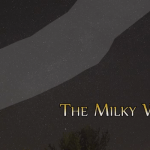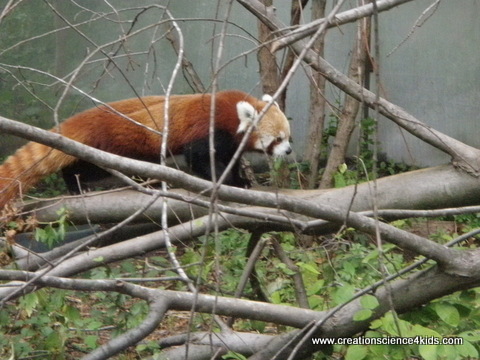
A few years ago we took our kids to a small local zoo and I got to see these critters for the first time. Even the daddies are so adorable I wanted to pick one up and snuggle (poor guy)! Like its neighbor, the Giant Panda, the Red Panda is endangered with only about 2,500 adults left alive right now. Unlike the Giant Panda, Red Pandas often have babies in zoos, making it much more hopeful that we can protect them for the future.
So, besides being as cute as a stuffed animal, what is a Red Panda like? They grow to be about the size of a house cat, but with an 18in [46cm] long tail (ringed like a Racoon), making them about 42in [106cm] long from nose to tip. They only weigh 7-13lbs [3-6kg], but they look heavier than that when you see them because their fur is so long and thick.
Like the Giant Panda, God has provided the Red Panda with a very unusual feature. Their wrists have a bony projection that works like a thumb that helps them hang on to things.
A Red Panda’s coloring helps it blend into the lichens growing on its forested environment. Their soft fur grows everywhere on them, in their ears and even on their paw pads. This is a good thing for them because they like to live in the mountains and cool forests where it snows in the Winter (which is why they’re comfortable in Michigan!). Their bushy tail makes a particularly excellent nose warmer for cold winter night!
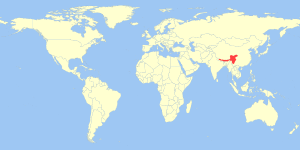
Red Pandas live wild on the band of high land running from India, Nepal and Bhutan on the west through China and as far east as northern Myanmar and Laos. Like the Giant Panda, their favorite food is bamboo, which is really hard to digest and has very few calories. This means both of these animals are dependent on a large and steady supply bamboo, but bamboo has a habit of all flowering and dying at once. I found a page with great pictures and everything you ever wanted to know about bamboo and more, but it’s really long. The info about Pandas’ diets and how the bamboo will die off is just past half way down the page. This is why the Pandas are in so much trouble. Farmers have cleared a lot of the land these animals used to roam around, so they are often stuck in one area where the bamboo might die suddenly.
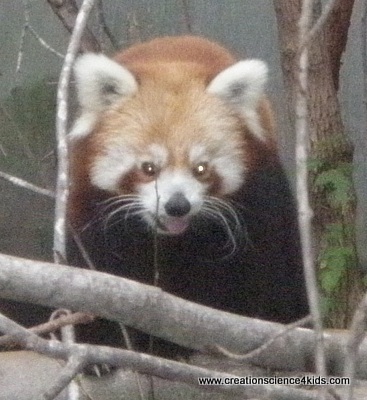 Unlike the Giant Panda, the Red Panda eats more than just bamboo, though. It is also fond of fruit and berries in the Summer and has even been known to occasionally eat eggs and baby birds, small rodents and bugs. Because of this better diet, Red Panda mothers usually have two babies each year and can bear up to 5! Baby Red Pandas stay with their mom until the next winter when they have to fend for themselves.
Unlike the Giant Panda, the Red Panda eats more than just bamboo, though. It is also fond of fruit and berries in the Summer and has even been known to occasionally eat eggs and baby birds, small rodents and bugs. Because of this better diet, Red Panda mothers usually have two babies each year and can bear up to 5! Baby Red Pandas stay with their mom until the next winter when they have to fend for themselves.
Adult Red Pandas live all alone except for mating time and when a mother is raising her babies. They only live to be about 13 years old in the wild with one known to have lived to 17 in captivity. This means an average mother could have about 20 babies in her life, but some of them are likely to be eaten by yellow martens (sort of like weasels) before they can grow up.
Red Pandas, being much smaller than the Giant ones, love to climb and hang out in trees. Their long tails help them balance as they move around on the branches. The one I saw at the zoo was taking a nap with its head stretched along a tree limb and its legs hanging down on both sides. Trees also make a good place to hide from snow leopards who find them tasty and people who like to turn their tails into wedding hats. They also tend to be fairly quiet, making twittering and whistling noises when they want to talk to each other.
National Geographic tells us that, “The red panda has given scientists taxonomic fits.” [tax-uh-nom-ic: put into groups] That means the Red Panda is a problem for people who want to say that everything developed from one animal along a bunch of Evolutionary paths that grew more and more unique from each other. Why? The Red panda is very similar to some animals that aren’t ‘supposed’ to be close on the ‘tree of life.’ They have a few features in common with the Giant Panda, which doesn’t surprise anyone. But, they have more in common with the raccoons of North America as well as weasels.
We know that all things were designed by one Master Creator and it doesn’t surprise us at all that the Red Panda is a variation on a number of God’s themes.
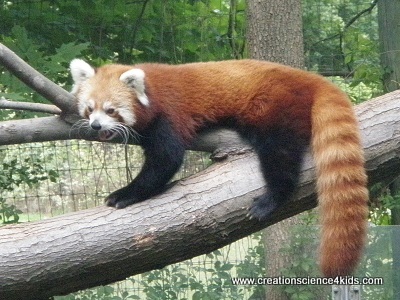
We’ve learned that there were once Red Pandas living in what is now North America. In 1977 a fossilized Red Panda tooth was found in Washington State. In the last ten years almost a whole fossilized skeleton has been found in Tennessee!! This article (put out by a moving company of all things) is very interesting. A bunch of animals (like the Saber-tooth Tiger, Shovel-tusk Elephant, and more) got washed into a sink hole along with at least two Red Pandas. Interestingly, the bones seem to show that they used to eat a wider variety of foods back then. But from what I’ve read about dinos, scientists have vivid imaginations about possible diets for fossilized critters.
The article didn’t mention how the bones sizes compare to modern ones, unfortunately. Pay attention to where the say the fossil Panda “has both primitive and derived characteristics.” That means they think it was both closer to and farther from the amoeba than modern ones! Right…
The page on Red Pandas at Animal Info had some interesting historical trivia about them. It says westerners were told about the Red Panda before the Giant Panda. It was first called the “Wah” (the Nepali name for it) after its loud call and then the “Poonya” which was another local name meaning “bamboo eater”. We English speakers had trouble saying this, so we changed the name to Panda. So the Red Panda got its name first and the Giant one borrowed it!
But ask now the beasts, and they shall teach thee; Who knoweth not in all these that the hand of the LORD hath wrought this? Job 12:7a,9
Photos by my dear husband and me taken at Binder Park Zoo near of Battle Creek, MI
-
Other sites I used to research this post:





